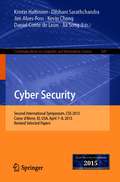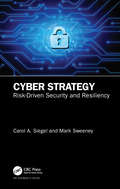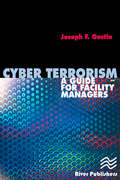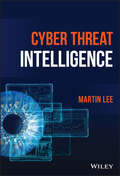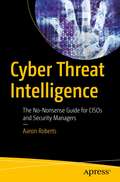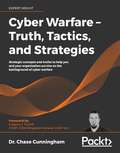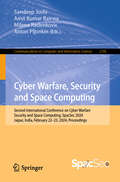- Table View
- List View
Cyber Security: Power and Technology (Intelligent Systems, Control and Automation: Science and Engineering #93)
by Pekka Neittaanmäki Martti LehtoThis book gathers the latest research results of scientists from different countries who have made essential contributions to the novel analysis of cyber security. Addressing open problems in the cyber world, the book consists of two parts. Part I focuses on cyber operations as a new tool in global security policy, while Part II focuses on new cyber security technologies when building cyber power capabilities. The topics discussed include strategic perspectives on cyber security and cyber warfare, cyber security implementation, strategic communication, trusted computing, password cracking, systems security and network security among others.
Cyber Security: Proceedings Of Csi 2015 (Advances In Intelligent Systems And Computing #729)
by M. U. Bokhari Namrata Agrawal Dharmendra SainiThis book comprises select proceedings of the annual convention of the Computer Society of India. Divided into 10 topical volumes, the proceedings present papers on state-of-the-art research, surveys, and succinct reviews. The volume covers diverse topics ranging from information security to cryptography and from encryption to intrusion detection. This book focuses on Cyber Security. It aims at informing the readers about the technology in general and the internet in particular. The book uncovers the various nuances of information security, cyber security and its various dimensions. This book also covers latest security trends, ways to combat cyber threats including the detection and mitigation of security threats and risks. The contents of this book will prove useful to professionals and researchers alike.
Cyber Security: Second International Symposium, CSS 2015, Coeur d'Alene, ID, USA, April 7-8, 2015, Revised Selected Papers (Communications in Computer and Information Science #589)
by Kristin Haltinner Dilshani Sarathchandra Jim Alves-Foss Kevin Chang Daniel Conte de Leon Jia SongThis book constitutes the refereed proceedings of the Second International Symposium on Cyber Security, CSS 2015, held in Coeur d'Alene, ID, USA, in April 2015. The 9 revised full papers presented were carefully reviewed and selected from 20 papers. The papers reflect four areas of scholarly work: permissions and trust evaluation, implementation and management; cloud and device security and privacy; social implications of networked and mobile applications; system and process assessments for improved cybersecurity.
Cyber Security: The Lifeline of Information and Communication Technology (Springer Series in Wireless Technology)
by Ramjee Prasad Vandana RohokaleThis book discusses a broad range of cyber security issues, addressing global concerns regarding cyber security in the modern era. The growth of Information and Communication Technology (ICT) and the prevalence of mobile devices make cyber security a highly topical and relevant issue. The transition from 4G to 5G mobile communication, while bringing convenience, also means cyber threats are growing exponentially. This book discusses a variety of problems and solutions including: • Internet of things and Machine to Machine Communication; • Infected networks such as Botnets; • Social media and networking; • Cyber Security for Smart Devices and Smart Grid • Blockchain Technology and • Artificial Intelligence for Cyber Security Given its scope, the book offers a valuable asset for cyber security researchers, as well as industry professionals, academics, and students.
Cyber Self-Defense: Expert Advice to Avoid Online Predators, Identity Theft, and Cyberbullying
by Laurie Edwards Alexis MooreAre you in danger of being cyberstalked? Have you been cyberbullied? Outwit your cyberattacker with these clever strategies from former cyberstalking victim, Alexis Moore. As the founder of Survivors in Action, Moore explains how to identify potential cyberattackers and how to recover from a cybercrime if you&’ve been attacked. Her indispensable book can help you remain secure and safe in today&’s dangerous digital world and take back control of your life.
Cyber Situational Awareness in Public-Private-Partnerships: Organisationsübergreifende Cyber-Sicherheitsvorfälle effektiv bewältigen
by Florian Skopik Maria Leitner Tímea PáhiDigitale Dienste werden für unsere Gesellschaft immer wichtiger, daher gelangen sie auch stärker ins Visier von Wirtschaftskriminellen, Spionen, Terroristen oder staatsfeindlichen Gruppierungen. Wie schützen sich Unternehmen und Staaten vor solchen Cyber-Attacken? Ein wichtiger Grundstein ist die Schaffung von Behörden, wie sie die EU-Richtlinie über Maßnahmen zur Gewährleistung eines hohen gemeinsamen Sicherheitsniveaus von Netz- und Informationssystemen (NIS) vorsieht. Das Buch zeigt, wie sich die Zusammenarbeit von Unternehmen mit diesen NIS-Behörden gestaltet mit dem gemeinsamen Ziel, Cyber-Sicherheit zu etablieren und zu gewährleisten. Darüber hinaus legen die Autoren dar, wie sich die NIS-Richtlinie und die im Mai 2018 in Kraft getretene EU-Datenschutz-Grundverordnung (DSGVO) auf Security-Prozesse in Unternehmen auswirken können. Das Buch verknüpft technische, organisatorische und rechtliche Aspekte der Zusammenarbeit und spiegelt damit die Komplexität des Themas wider. Zugleich liefert es zahlreiche Vorschläge zur Umsetzung der EU-Richtlinie. Im Mittelpunkt steht dabei das Konzept der „Cyber Situational Awareness“ – das bewusste Erfassen der aktuellen Lage – und damit ein Instrument, mit dem sich die Reaktionsfähigkeit bei Cyber-Angriffen wesentlich erhöhen lässt. Folgende Themen werden erläutert: • Aufbau und Nutzung von Cyber Situational Awareness • Erstellung von Cyber-Lagebildern auf nationaler Ebene • Informations- und Datenquellen für Cyber-Lagebilder• Informationsaustausch zwischen Cyber-Lagezentren und Stakeholdern • Informations- und Meldepflichten von Unternehmen• Planspiel zur Bildung und Evaluierung von Cyber Situational Awareness
Cyber Smart: Five Habits to Protect Your Family, Money, and Identity from Cyber Criminals
by Bart R. McDonoughAn easy-to-read guide to protecting your digital life and your family online The rise of new technologies in our lives, which has taken us from powerful mobile phones to fitness trackers and smart appliances in under a decade, has also raised the need for everyone who uses these to protect themselves from cyber scams and hackers. Every new device and online service you use that improves your life also opens new doors for attackers looking to discover your passwords, banking accounts, personal photos, and anything else you want to keep secret. In Cyber Smart, author Bart McDonough uses his extensive cybersecurity experience speaking at conferences for the FBI, major financial institutions, and other clients to answer the most common question he hears: “How can I protect myself at home, on a personal level, away from the office?” McDonough knows cybersecurity and online privacy are daunting to the average person so Cyber Smart simplifies online good hygiene with five simple “Brilliance in the Basics” habits anyone can learn. With those habits and his careful debunking of common cybersecurity myths you’ll be able to protect yourself and your family from: Identify theft Compromising your children Lost money Lost access to email and social media accounts Digital security is one of the most important, and least understood, aspects of our daily lives. But it doesn’t have to be. Thanks to its clear instruction, friendly tone, and practical strategies, Cyber Smart will help you rest more easily, knowing you and your family are protected from digital attack.
Cyber Space and Outer Space Security (River Publishers Series in Digital Security and Forensics)
by Polinpapilinho F. Katina Karthikeyan Periyasami Rajagopal RamasamyThis book delves into cutting-edge research in cyberspace and outer space security, encompassing both theoretical and experimental aspects. It provides mitigation measures and strategies to address the identified challenges within. It covers a spectrum of topics including techniques and strategies for enhancing cyberspace security, combating ransomware attacks, and securing autonomous vehicles. Additionally, it explores security and surveillance systems involving autonomous vehicles, resilience schemes against security attacks using blockchain for autonomous vehicles, security analysis of autonomous drones (UAVs), the cybersecurity kill chain, the internet of drones (IoD), and cyberspace solutions to counteract attacks. The discussion extends to mitigation strategies against weaponized AI in cyber-attacks, countermeasures for both autonomous vehicles and cyberspace attacks, as well as the limitations and future prospects of artificial intelligence (AI) and data defense in aerospace cybersecurity.A network comprising nodes can establish both cyberspace and outer space platforms for data exchange. Cyberspace finds diverse applications, including commercial endeavors and military defense. The integration of autonomous vehicles, unmanned aircraft systems (UAS), and drones into outer space environments is facilitated through their connection to cyberspace. One illustrative example involves the utilization of blockchain-based secure drone systems for product delivery, leveraging the combined capabilities of cyberspace and outer space security technologies. This book elucidates the intricate dynamics between cyber operations and the expanding realm of autonomous outer cyberspace, presenting new security challenges arising from heightened complexity and emerging vulnerabilities.
Cyber Strategy: Risk-Driven Security and Resiliency
by Carol A. Siegel Mark SweeneyCyber Strategy: Risk-Driven Security and Resiliency provides a process and roadmap for any company to develop its unified Cybersecurity and Cyber Resiliency strategies. It demonstrates a methodology for companies to combine their disassociated efforts into one corporate plan with buy-in from senior management that will efficiently utilize resources, target high risk threats, and evaluate risk assessment methodologies and the efficacy of resultant risk mitigations. The book discusses all the steps required from conception of the plan from preplanning (mission/vision, principles, strategic objectives, new initiatives derivation), project management directives, cyber threat and vulnerability analysis, cyber risk and controls assessment to reporting and measurement techniques for plan success and overall strategic plan performance. In addition, a methodology is presented to aid in new initiative selection for the following year by identifying all relevant inputs. Tools utilized include: Key Risk Indicators (KRI) and Key Performance Indicators (KPI) National Institute of Standards and Technology (NIST) Cyber Security Framework (CSF) Target State Maturity interval mapping per initiative Comparisons of current and target state business goals and critical success factors A quantitative NIST-based risk assessment of initiative technology components Responsible, Accountable, Consulted, Informed (RACI) diagrams for Cyber Steering Committee tasks and Governance Boards’ approval processes Swimlanes, timelines, data flow diagrams (inputs, resources, outputs), progress report templates, and Gantt charts for project management The last chapter provides downloadable checklists, tables, data flow diagrams, figures, and assessment tools to help develop your company’s cybersecurity and cyber resiliency strategic plan.
Cyber Technologies and Emerging Sciences: ICCTES 2021 (Lecture Notes in Networks and Systems #467)
by Sateesh K. Peddoju Sudhanshu Maurya Badlishah Ahmad Ines ChihiThe book is a collection of best selected research papers presented at International Conference on Cyber-Technologies and Emerging Sciences (ICCTES 2021), organized by Graphic Era Hill University, Bhimtal Campus, Uttarakhand, India, during 17 – 18 December 2021. The book covers state-of-the-art applications, innovative methods, and analyze the unexplored and unsolved challenges to establish the relative solutions to advance the existing applications and theories of Cyber-Technologies and Emerging Sciences.
Cyber Terrorism: A Guide for Facility Managers
by Joseph F. GustinCyber Terrorism: A Guide for Facility Managers addresses cyberterrorism and other forms of terrorist activity including mailroom security, bomb threats, and the constant attacks from viruses, hackers, and other invasive programs.
Cyber Threat Hunting
by Nadhem AlFardanFollow the clues, track down the bad actors trying to access your systems, and uncover the chain of evidence left by even the most careful adversary.Cyber Threat Hunting teaches you how to identify potential breaches of your security. Practical and easy-to-follow, it gives you a reliable and repeatable framework to see and stop attacks. In Cyber Threat Hunting you will learn how to: • Design and implement a cyber threat hunting framework • Think like your adversaries • Conduct threat hunting expeditions • Streamline how you work with other cyber security teams • Structure threat hunting expeditions without losing track of activities and clues • Use statistics and machine learning techniques to hunt for threats Organizations that actively seek out security intrusions reduce the time that bad actors spend on their sites, increase their cyber resilience, and build strong resistance to sophisticated covert threats. Cyber Threat Hunting teaches you to recognize attempts to access your systems by seeing the clues your adversaries leave behind. It lays out the path to becoming a successful cyber security threat hunter, guiding you from your very first expedition to hunting in complex cloud-native environments. Foreword by Anton Chuvakin. About the technology Right now, an intruder may be lurking in your network, silently mapping your infrastructure and siphoning off sensitive data. Can you spot the subtle signs? Cyber threat hunting is a security practice aimed at uncovering network and software threats that slip past monitoring and detection systems, and other reactive techniques. In this practical book, author Nadhem AlFardan uses real-world scenarios to help you think like a threat hunter and maximize the success of your expeditions. About the book Cyber Threat Hunting teaches you how to conduct structured expeditions using techniques that can detect even the most sophisticated cybersecurity challenges. You&’ll begin by mastering the fundamentals: formulating a threat hypothesis, gathering intelligence, strategizing your approach, and executing your hunt. From there, you&’ll explore advanced techniques, including machine learning and statistical analysis for anomaly detection. Using this book&’s downloadable datasets and scenario templates, you&’ll get the hands-on experience you need to refine your threat-hunting expertise. What's inside • A threat hunting framework and toolkit • Think like an adversary • Effective threat hunting operations About the reader For security, network, and systems professionals with some Python experience. About the author Nadhem AlFardan, a distinguished architect, leads the Security Operation Center practice team in Cisco Customer Experience, APJC. Table of Contents Part 1 1 Introducing threat hunting 2 Building the foundation of a threat-hunting practice Part 2 3 Your first threat-hunting expedition 4 Threat intelligence for threat hunting 5 Hunting in clouds Part 3 6 Using fundamental statistical constructs 7 Tuning statistical logic 8 Unsupervised machine learning with k-means 9 Supervised machine learning with Random Forest and XGBoost 10 Hunting with deception Part 4 11 Responding to findings 12 Measuring success 13 Enabling the team Appendix A Useful Tools
Cyber Threat Intelligence
by Martin LeeCYBER THREAT INTELLIGENCE “Martin takes a thorough and focused approach to the processes that rule threat intelligence, but he doesn’t just cover gathering, processing and distributing intelligence. He explains why you should care who is trying to hack you, and what you can do about it when you know.” —Simon Edwards, Security Testing Expert, CEO SE Labs Ltd., Chair AMTSO Effective introduction to cyber threat intelligence, supplemented with detailed case studies and after action reports of intelligence on real attacks Cyber Threat Intelligence introduces the history, terminology, and techniques to be applied within cyber security, offering an overview of the current state of cyberattacks and stimulating readers to consider their own issues from a threat intelligence point of view. The author takes a systematic, system-agnostic, and holistic view to generating, collecting, and applying threat intelligence. The text covers the threat environment, malicious attacks, collecting, generating, and applying intelligence and attribution, as well as legal and ethical considerations. It ensures readers know what to look out for when considering a potential cyber attack and imparts how to prevent attacks early on, explaining how threat actors can exploit a system’s vulnerabilities. It also includes analysis of large scale attacks such as WannaCry, NotPetya, Solar Winds, VPNFilter, and the Target breach, looking at the real intelligence that was available before and after the attack. Topics covered in Cyber Threat Intelligence include: The constant change of the threat environment as capabilities, intent, opportunities, and defenses change and evolve Different business models of threat actors, and how these dictate the choice of victims and the nature of their attacks Planning and executing a threat intelligence programme to improve an organistation’s cyber security posture Techniques for attributing attacks and holding perpetrators to account for their actions Cyber Threat Intelligence describes the intelligence techniques and models used in cyber threat intelligence. It provides a survey of ideas, views and concepts, rather than offering a hands-on practical guide. It is intended for anyone who wishes to learn more about the domain, particularly if they wish to develop a career in intelligence, and as a reference for those already working in the area.
Cyber Threat Intelligence (Advances in Information Security #70)
by Mauro Conti Ali Dehghantanha Tooska DargahiThis book provides readers with up-to-date research of emerging cyber threats and defensive mechanisms, which are timely and essential. It covers cyber threat intelligence concepts against a range of threat actors and threat tools (i.e. ransomware) in cutting-edge technologies, i.e., Internet of Things (IoT), Cloud computing and mobile devices. This book also provides the technical information on cyber-threat detection methods required for the researcher and digital forensics experts, in order to build intelligent automated systems to fight against advanced cybercrimes.The ever increasing number of cyber-attacks requires the cyber security and forensic specialists to detect, analyze and defend against the cyber threats in almost real-time, and with such a large number of attacks is not possible without deeply perusing the attack features and taking corresponding intelligent defensive actions – this in essence defines cyber threat intelligence notion. However, such intelligence would not be possible without the aid of artificial intelligence, machine learning and advanced data mining techniques to collect, analyze, and interpret cyber-attack campaigns which is covered in this book. This book will focus on cutting-edge research from both academia and industry, with a particular emphasis on providing wider knowledge of the field, novelty of approaches, combination of tools and so forth to perceive reason, learn and act on a wide range of data collected from different cyber security and forensics solutions. This book introduces the notion of cyber threat intelligence and analytics and presents different attempts in utilizing machine learning and data mining techniques to create threat feeds for a range of consumers. Moreover, this book sheds light on existing and emerging trends in the field which could pave the way for future works. The inter-disciplinary nature of this book, makes it suitable for a wide range of audiences with backgrounds in artificial intelligence, cyber security, forensics, big data and data mining, distributed systems and computer networks. This would include industry professionals, advanced-level students and researchers that work within these related fields.
Cyber Threat Intelligence for the Internet of Things
by Elias Bou-Harb Nataliia NeshenkoThis book reviews IoT-centric vulnerabilities from a multidimensional perspective by elaborating on IoT attack vectors, their impacts on well-known security objectives, attacks which exploit such vulnerabilities, coupled with their corresponding remediation methodologies. This book further highlights the severity of the IoT problem at large, through disclosing incidents of Internet-scale IoT exploitations, while putting forward a preliminary prototype and associated results to aid in the IoT mitigation objective. Moreover, this book summarizes and discloses findings, inferences, and open challenges to inspire future research addressing theoretical and empirical aspects related to the imperative topic of IoT security.At least 20 billion devices will be connected to the Internet in the next few years. Many of these devices transmit critical and sensitive system and personal data in real-time. Collectively known as “the Internet of Things” (IoT), this market represents a $267 billion per year industry. As valuable as this market is, security spending on the sector barely breaks 1%. Indeed, while IoT vendors continue to push more IoT devices to market, the security of these devices has often fallen in priority, making them easier to exploit. This drastically threatens the privacy of the consumers and the safety of mission-critical systems.This book is intended for cybersecurity researchers and advanced-level students in computer science. Developers and operators working in this field, who are eager to comprehend the vulnerabilities of the Internet of Things (IoT) paradigm and understand the severity of accompanied security issues will also be interested in this book.
Cyber Threat Intelligence: The No-Nonsense Guide for CISOs and Security Managers
by Aaron RobertsUnderstand the process of setting up a successful cyber threat intelligence (CTI) practice within an established security team. This book shows you how threat information that has been collected, evaluated, and analyzed is a critical component in protecting your organization’s resources. Adopting an intelligence-led approach enables your organization to nimbly react to situations as they develop. Security controls and responses can then be applied as soon as they become available, enabling prevention rather than response. There are a lot of competing approaches and ways of working, but this book cuts through the confusion. Author Aaron Roberts introduces the best practices and methods for using CTI successfully. This book will help not only senior security professionals, but also those looking to break into the industry. You will learn the theories and mindset needed to be successful in CTI. This book covers the cybersecurity wild west, the merits and limitations of structured intelligence data, and how using structured intelligence data can, and should, be the standard practice for any intelligence team. You will understand your organizations’ risks, based on the industry and the adversaries you are most likely to face, the importance of open-source intelligence (OSINT) to any CTI practice, and discover the gaps that exist with your existing commercial solutions and where to plug those gaps, and much more. What You Will Learn Know the wide range of cybersecurity products and the risks and pitfalls aligned with blindly working with a vendorUnderstand critical intelligence concepts such as the intelligence cycle, setting intelligence requirements, the diamond model, and how to apply intelligence to existing security informationUnderstand structured intelligence (STIX) and why it’s important, and aligning STIX to ATT&CK and how structured intelligence helps improve final intelligence reportingKnow how to approach CTI, depending on your budgetPrioritize areas when it comes to funding and the best approaches to incident response, requests for information, or ad hoc reportingCritically evaluate services received from your existing vendors, including what they do well, what they don’t do well (or at all), how you can improve on this, the things you should consider moving in-house rather than outsourcing, and the benefits of finding and maintaining relationships with excellent vendors Who This Book Is For Senior security leaders in charge of cybersecurity teams who are considering starting a threat intelligence team, those considering a career change into cyber threat intelligence (CTI) who want a better understanding of the main philosophies and ways of working in the industry, and security professionals with no prior intelligence experience but have technical proficiency in other areas (e.g., programming, security architecture, or engineering)
Cyber Threats and Nuclear Weapons
by Herbert LinThe technology controlling United States nuclear weapons predates the Internet. Updating the technology for the digital era is necessary, but it comes with the risk that anything digital can be hacked. Moreover, using new systems for both nuclear and non-nuclear operations will lead to levels of nuclear risk hardly imagined before. This book is the first to confront these risks comprehensively. With Cyber Threats and Nuclear Weapons, Herbert Lin provides a clear-eyed breakdown of the cyber risks to the U.S. nuclear enterprise. Featuring a series of scenarios that clarify the intersection of cyber and nuclear risk, this book guides readers through a little-understood element of the risk profile that government decision-makers should be anticipating. What might have happened if the Cuban Missile Crisis took place in the age of Twitter, with unvetted information swirling around? What if an adversary announced that malware had compromised nuclear systems, clouding the confidence of nuclear decision-makers? Cyber Threats and Nuclear Weapons, the first book to consider cyber risks across the entire nuclear enterprise, concludes with crucial advice on how government can manage the tensions between new nuclear capabilities and increasing cyber risk. This is an invaluable handbook for those ready to confront the unique challenges of cyber nuclear risk.
Cyber War: The Next Threat to National Security and What to Do About It
by Richard A. Clarke Robert K. KnakeAn essential, eye-opening book about cyberterrorism, cyber war, and the next great threat to our national security. “Cyber War may be the most important book about national security policy in the last several years.” –SlateFormer presidential advisor and counter-terrorism expert Richard A. Clarke sounds a timely and chilling warning about America’s vulnerability in a terrifying new international conflict. Cyber War is a powerful book about technology, government, and military strategy; about criminals, spies, soldiers, and hackers. It explains clearly and convincingly what cyber war is, and how vulnerable we are as a nation and as individuals to the vast and looming web of cyber criminals.Every concerned American should read this startling and explosive book that offers an insider’s view of White House ‘Situation Room’ operations and carries the reader to the frontlines of our cyber defense. Cyber War exposes a virulent threat to our nation’s security.
Cyber Warfare – Truth, Tactics, and Strategies: Strategic concepts and truths to help you and your organization survive on the battleground of cyber warfare
by Gregory J. Touhill Dr. Chase CunninghamInsights into the true history of cyber warfare, and the strategies, tactics, and cybersecurity tools that can be used to better defend yourself and your organization against cyber threat. Key Features Define and determine a cyber-defence strategy based on current and past real-life examples Understand how future technologies will impact cyber warfare campaigns and society Future-ready yourself and your business against any cyber threat Book Description The era of cyber warfare is now upon us. What we do now and how we determine what we will do in the future is the difference between whether our businesses live or die and whether our digital self survives the digital battlefield. Cyber Warfare – Truth, Tactics, and Strategies takes you on a journey through the myriad of cyber attacks and threats that are present in a world powered by AI, big data, autonomous vehicles, drones video, and social media. Dr. Chase Cunningham uses his military background to provide you with a unique perspective on cyber security and warfare. Moving away from a reactive stance to one that is forward-looking, he aims to prepare people and organizations to better defend themselves in a world where there are no borders or perimeters. He demonstrates how the cyber landscape is growing infinitely more complex and is continuously evolving at the speed of light. The book not only covers cyber warfare, but it also looks at the political, cultural, and geographical influences that pertain to these attack methods and helps you understand the motivation and impacts that are likely in each scenario. Cyber Warfare – Truth, Tactics, and Strategies is as real-life and up-to-date as cyber can possibly be, with examples of actual attacks and defense techniques, tools. and strategies presented for you to learn how to think about defending your own systems and data. What you will learn Hacking at scale – how machine learning (ML) and artificial intelligence (AI) skew the battlefield Defending a boundaryless enterprise Using video and audio as weapons of influence Uncovering DeepFakes and their associated attack vectors Using voice augmentation for exploitation Defending when there is no perimeter Responding tactically to counter-campaign-based attacks Who this book is for This book is for any engineer, leader, or professional with either a responsibility for cyber security within their organizations, or an interest in working in this ever-growing field.
Cyber Warfare, Security and Space Computing: Second International Conference on Cyber Warfare, Security and Space Computing, SpacSec 2024, Jaipur, India, February 22–23, 2024, Proceedings (Communications in Computer and Information Science #2195)
by Anton Pljonkin Sandeep Joshi Amit Kumar Bairwa Milena RadenkovicThis book constitutes selected papers from the Second International Conference on Cyber Warfare, Security and Space Research, SpacSec 2024, held in Jaipur, India, on February 22–23, 2024. The 27 papers presented here were carefully reviewed and selected from 333 submissions. These papers focus on various domains of Cyber warfare and Space computing, including emerging research and applications in the field.
Cyber Warfare, Security and Space Research: First International Conference, SpacSec 2021, Jaipur, India, December 9–10, 2021, Revised Selected Papers (Communications in Computer and Information Science #1599)
by Sandeep Joshi Amit Kumar Bairwa Amita Nandal Milena Radenkovic Cem AvsarThis book sonstitutes selected papers from the first International Conference on Cyber Warfare, Security and Space Research, SpacSec 2021, held in Jaipur, India, in December 2021.The 19 full and 6 short papers were thoroughly reviewed and selected from the 98 submissions. The papers present research on cyber warfare, cyber security, and space research area, including the understanding of threats and risks to systems, the development of a strong innovative culture, and incident detection and post-incident investigation.
Cyber Warfare: A Multidisciplinary Analysis (Routledge Studies in Conflict, Security and Technology)
by James GreenThis book is a multi-disciplinary analysis of cyber warfare, featuring contributions by leading experts from a mixture of academic and professional backgrounds. Cyber warfare, meaning interstate cyber aggression, is an increasingly important emerging phenomenon in international relations, with state-orchestrated (or apparently state-orchestrated) computer network attacks occurring in Estonia (2007), Georgia (2008) and Iran (2010). This method of waging warfare – given its potential to, for example, make planes fall from the sky or cause nuclear power plants to melt down – has the capacity to be as devastating as any conventional means of conducting armed conflict. Every state in the world now has a cyber-defence programme and over 120 states also have a cyber-attack programme. While the amount of literature on cyber warfare is growing within disciplines, our understanding of the subject has been limited by a lack of cross-disciplinary engagement. In response, this book, drawn from the fields of computer science, military strategy, international law, political science and military ethics, provides a critical overview of cyber warfare for those approaching the topic from whatever angle. Chapters consider the emergence of the phenomena of cyber warfare in international affairs; what cyber-attacks are from a technological standpoint; the extent to which cyber-attacks can be attributed to state actors; the strategic value and danger posed by cyber conflict; the legal regulation of cyber-attacks, both as international uses of force and as part of an on-going armed conflict, and the ethical implications of cyber warfare. This book will be of great interest to students of cyber warfare, cyber security, military ethics, international law, security studies and IR in general.
Cyber Warfare: Building the Scientific Foundation (Advances in Information Security #56)
by Sushil Jajodia Cliff Wang V. S. Subrahmanian Vipin Swarup Paulo ShakarianThis book features a wide spectrum of the latest computer science research relating to cyber warfare, including military and policy dimensions. It is the first book to explore the scientific foundation of cyber warfare and features research from the areas of artificial intelligence, game theory, programming languages, graph theory and more. The high-level approach and emphasis on scientific rigor provides insights on ways to improve cyber warfare defense worldwide. Cyber Warfare: Building the Scientific Foundation targets researchers and practitioners working in cyber security, especially government employees or contractors. Advanced-level students in computer science and electrical engineering with an interest in security will also find this content valuable as a secondary textbook or reference.
Cyber Wars: Hacks that Shocked the Business World
by Charles ArthurCyber Wars gives you the dramatic inside stories of some of the world's biggest cyber attacks. These are the game changing hacks that make organizations around the world tremble and leaders stop and consider just how safe they really are. Charles Arthur provides a gripping account of why each hack happened, what techniques were used, what the consequences were and how they could have been prevented. Cyber attacks are some of the most frightening threats currently facing business leaders and this book provides a deep insight into understanding how they work, how hackers think as well as giving invaluable advice on staying vigilant and avoiding the security mistakes and oversights that can lead to downfall. No organization is safe but by understanding the context within which we now live and what the hacks of the future might look like, you can minimize the threat. In Cyber Wars, you will learn how hackers in a TK Maxx parking lot managed to steal 94m credit card details costing the organization $1bn; how a 17 year old leaked the data of 157,000 TalkTalk customers causing a reputational disaster; how Mirai can infect companies' Internet of Things devices and let hackers control them; how a sophisticated malware attack on Sony caused corporate embarrassment and company-wide shut down; and how a phishing attack on Clinton Campaign Chairman John Podesta's email affected the outcome of the 2016 US election.
Cyber Weaponry: Issues And Implications Of Digital Arms (Advanced Sciences and Technologies for Security Applications)
by Henry PrunckunThere is little doubt that cyber-space has become the battle space for confrontations. However, to conduct cyber operations, a new armory of weapons needs to be employed. No matter how many, or how sophisticated an aggressor’s kinetic weapons are, they are useless in cyber-space. This book looks at the milieu of the cyber weapons industry, as well as the belligerents who use cyber weapons. It discusses what distinguishes these hardware devices and software programs from computer science in general. It does this by focusing on specific aspects of the topic—contextual issues of why cyber-space is the new battleground, defensive cyber weapons, offensive cyber weapons, dual-use weapons, and the implications these weapons systems have for practice. Contrary to popular opinion, the use of cyber weapons is not limited to nation states; though this is where the bulk of news reporting focuses. The reality is that there isn’t a sector of the political-economy that is immune to cyber skirmishes. So, this book looks at cyber weapons not only by national security agencies and the military, but also by law enforcement, and the business sector—the latter includes administrations termed non-government organisations (NGOs). This book offers study material suitable for a wide-ranging audience—students, professionals, researchers, policy officers, and ICT specialists.


